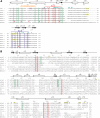Structural basis for the antiproliferative activity of the Tob-hCaf1 complex
- PMID: 19276069
- PMCID: PMC2676056
- DOI: 10.1074/jbc.M809250200
Structural basis for the antiproliferative activity of the Tob-hCaf1 complex
Abstract
The Tob/BTG family is a group of antiproliferative proteins containing two highly homologous regions, Box A and Box B. These proteins all associate with CCR4-associated factor 1 (Caf1), which belongs to the ribonuclease D (RNase D) family of deadenylases and is a component of the CCR4-Not deadenylase complex. Here we determined the crystal structure of the complex of the N-terminal region of Tob and human Caf1 (hCaf1). Tob exhibited a novel fold, whereas hCaf1 most closely resembled the catalytic domain of yeast Pop2 and human poly(A)-specific ribonuclease. Interestingly, the association of hCaf1 was mediated by both Box A and Box B of Tob. Cell growth assays using both wild-type and mutant proteins revealed that deadenylase activity of Caf1 is not critical but complex formation is crucial to cell growth inhibition. Caf1 tethers Tob to the CCR4-Not deadenylase complex, and thereby Tob gathers several factors at its C-terminal region, such as poly(A)-binding proteins, to exert antiproliferative activity.
Figures







Similar articles
-
Crystallization and preliminary crystallographic analysis of the Tob-hCaf1 complex.Acta Crystallogr Sect F Struct Biol Cryst Commun. 2007 Dec 1;63(Pt 12):1061-3. doi: 10.1107/S1744309107057466. Epub 2007 Nov 30. Acta Crystallogr Sect F Struct Biol Cryst Commun. 2007. PMID: 18084094 Free PMC article.
-
Quantitative characterization of Tob interactions provides the thermodynamic basis for translation termination-coupled deadenylase regulation.J Biol Chem. 2010 Sep 3;285(36):27624-31. doi: 10.1074/jbc.M110.138867. Epub 2010 Jul 1. J Biol Chem. 2010. PMID: 20595394 Free PMC article.
-
The anti-proliferative activity of BTG/TOB proteins is mediated via the Caf1a (CNOT7) and Caf1b (CNOT8) deadenylase subunits of the Ccr4-not complex.PLoS One. 2012;7(12):e51331. doi: 10.1371/journal.pone.0051331. Epub 2012 Dec 7. PLoS One. 2012. PMID: 23236473 Free PMC article.
-
The mammalian anti-proliferative BTG/Tob protein family.J Cell Physiol. 2010 Jan;222(1):66-72. doi: 10.1002/jcp.21919. J Cell Physiol. 2010. PMID: 19746446 Review.
-
BTG/TOB factors impact deadenylases.Trends Biochem Sci. 2009 Dec;34(12):640-7. doi: 10.1016/j.tibs.2009.07.008. Epub 2009 Oct 12. Trends Biochem Sci. 2009. PMID: 19828319 Free PMC article. Review.
Cited by
-
Catalytides derived from the Box A region in the ANA/BTG3 protein cleave amyloid-β fragment peptide.Heliyon. 2019 Sep 24;5(9):e02454. doi: 10.1016/j.heliyon.2019.e02454. eCollection 2019 Sep. Heliyon. 2019. PMID: 31687556 Free PMC article.
-
A genome-wide CRISPR screening uncovers that TOB1 acts as a key host factor for FMDV infection via both IFN and EGFR mediated pathways.PLoS Pathog. 2024 Mar 21;20(3):e1012104. doi: 10.1371/journal.ppat.1012104. eCollection 2024 Mar. PLoS Pathog. 2024. PMID: 38512977 Free PMC article.
-
Structural basis for inhibition of the Tob-CNOT7 interaction by a fragment screening approach.Protein Cell. 2015 Dec;6(12):924-8. doi: 10.1007/s13238-015-0225-6. Protein Cell. 2015. PMID: 26518565 Free PMC article. No abstract available.
-
Advances in the genetic etiology of female infertility.J Assist Reprod Genet. 2024 Dec;41(12):3261-3286. doi: 10.1007/s10815-024-03248-w. Epub 2024 Sep 25. J Assist Reprod Genet. 2024. PMID: 39320554 Review.
-
An RNA-Binding Multimer Specifies Nematode Sperm Fate.Cell Rep. 2018 Jun 26;23(13):3769-3775. doi: 10.1016/j.celrep.2018.05.095. Cell Rep. 2018. PMID: 29949762 Free PMC article.
References
-
- Tirone, F. (2001) J. Cell. Physiol. 187 155-165 - PubMed
-
- Matsuda, S., Rouault, J., Magaud, J., and Berthet, C. (2001) FEBS Lett. 497 67-72 - PubMed
-
- Matsuda, S., Kawamura-Tsuzuku, J., Ohsugi, M., Yoshida, M., Emi, M., Nakamura, Y., Onda, M., Yoshida, Y., Nishiyama, A., and Yamamoto, T. (1996) Oncogene 12 705-713 - PubMed
-
- Ikematsu, N., Yoshida, Y., Kawamura-Tsuzuku, J., Ohsugi, M., Onda, M., Hirai, M., Fujimoto, J., and Yamamoto, T. (1999) Oncogene 18 7432-7441 - PubMed
Publication types
MeSH terms
Substances
LinkOut - more resources
Full Text Sources
Molecular Biology Databases

